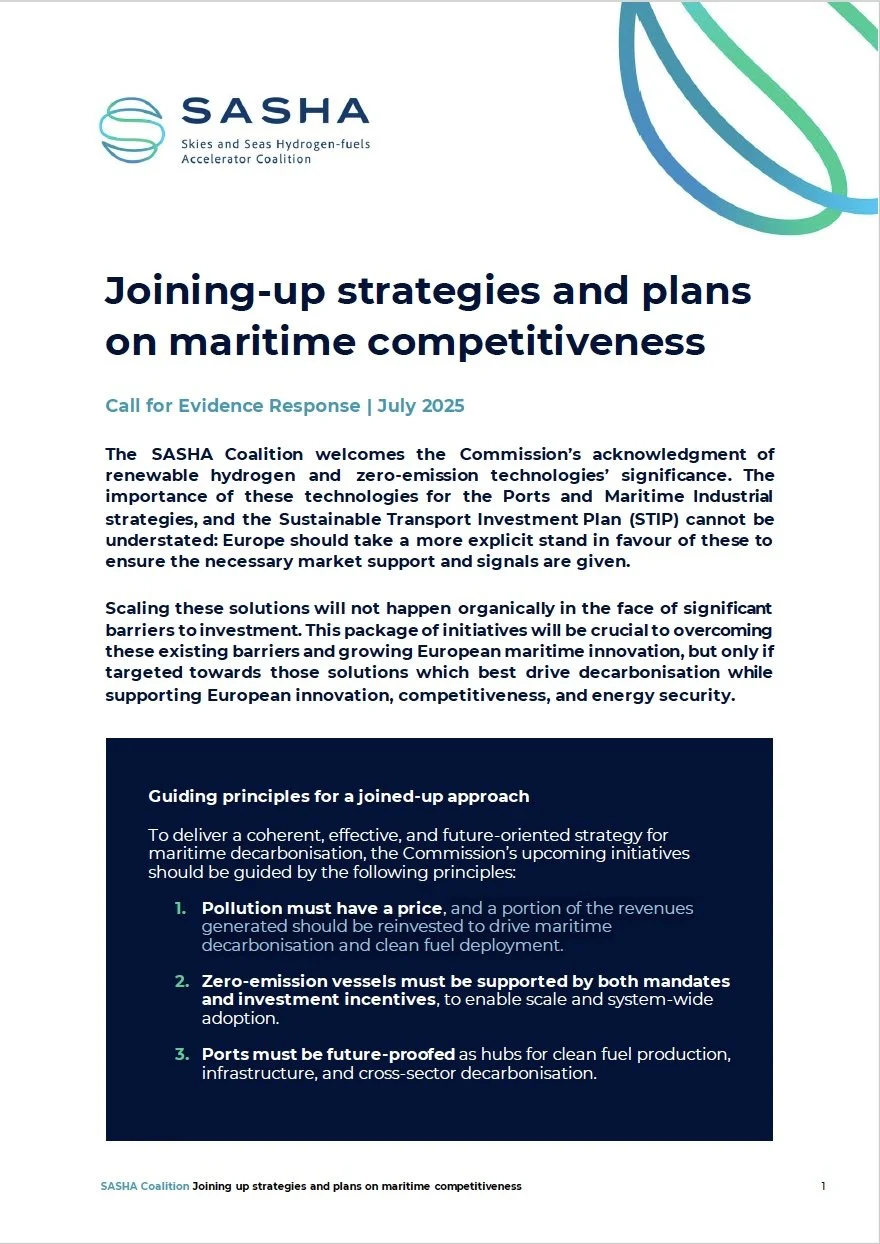
Joining-up EU strategies on maritime competitiveness
Call for evidence response | July 2025
Introduction
In response to the European Commission’s calls for evidence on Europe’s industrial maritime strategy and ports strategy, the SASHA Coalition highlights the importance of a joined-up approach to accelerate maritime decarbonisation and maximise its benefits for competitive European industry.
The SASHA Coalition welcomes the Commission’s acknowledgment of renewable hydrogen and zero-emission technologies’ significance. The importance of these technologies for the Ports and Maritime Industrial strategies, and the Sustainable Transport Investment Plan (STIP) cannot be understated: Europe should take a more explicit stand in favour of these to ensure the necessary market support and signals are given.
Scaling these solutions will not happen organically in the face of significant barriers to investment. This package of initiatives will be crucial to overcoming these existing barriers and growing European maritime innovation, but only if targeted towards those solutions which best drive decarbonisation while supporting European innovation, competitiveness, and energy security.
Guiding principles for a joined-up approach
To deliver a coherent, effective, and future-oriented strategy for maritime decarbonisation, the Commission’s upcoming initiatives should be guided by the following principles:
Pollution must have a price, and a portion of the revenues generated should be reinvested to drive maritime decarbonisation and clean fuel deployment.
Zero-emission vessels must be supported by both mandates and investment incentives, to enable scale and system-wide adoption.
Ports must be future-proofed as hubs for clean fuel production, infrastructure, and cross-sector decarbonisation.
Making an explicit choice for renewable hydrogen-solutions
Europe’s far-reaching dependence on imports for its energy supplies has proven to be problematic on multiple levels, be it on national security issues, trade disputes, or industry competitiveness. Using this wake-up call to strategically invest in the types of energy production that can be sourced entirely within Europe is urgent.
Ports play a vital role in this already, serving as nodes for on-shoring of off-shore renewable electricity, and are often co-located with other industrial energy uses. Ship building is equally heavily affected by the energy choices of the continent, with a potential for unlocking innovation in clean shipping technologies that can position Europe well to take the lead on ship building.
Europe should make the choice to unapologetically back renewable hydrogen-based solutions over other, less or entirely unsustainable and more import-reliant options like LNG or biofuels. The Ports and Industrial Maritime Strategies and the STIP should align on a clear choice for hydrogen and e-fuels, to ensure investments follow suit.
Making this choice also brings Europe’s continued leadership position on innovation in clean tech into view: stable policy-making that opts for clear, durable solutions for how decarbonisation and energy sovereignty should look like provides the necessary investment security for such an industry to thrive.
This enabling environment must nevertheless also include a serious look at fuel supply challenges, especially for fuels like ammonia. The strategies should address infrastructure, safety, and environmental concerns related to these fuels.
With a clear choice for the types of energy sources it wants to back, Europe will pave the way for a boost in new shipping vessels, be they battery-electric, fuel cell-electric, or running on drop in e-fuel. All sizes ships can fall under these categories, with both retrofitting and new builds as options. A fuel choice for energy sovereignty means a clear signal for the entire value chain.
Putting into place mandates for zero emission vessels, particularly on inland waterways where the transition would currently be easiest apply is key. Without such a mandate, the often-used excuse of chicken-and-egg dilemma will hold back the sector’s potential.
Focusing on the broader picture by including other sectors
Ensuring the three announced files - the Ports Strategy, the Maritime Industrial Strategy and the STIP – align among each other and look more broadly, particularly on renewable electricity deployment, grids, heavy industry, and aviation, is central to a successful strategy that works towards European competitiveness and sustainability goals.
The Maritime industrial strategy looks at the full maritime supply chain which is an encouraging start. Indeed, ensuring that zero emission vessels are constructed is one thing, but ensuring the necessary infrastructure is in place for the production and transportation of renewable electricity and hydrogen is key for a working value chain to be created.
Considering ports are lagging behind on their obligation to provide shore power infrastructure, Europe needs to stand its ground on this Alternative Fuel Infrastructure Regulation obligation and in time, extend it to a larger array of berthed ships. Shore-side power is essential to combat air pollution in ports that are often close to densely populated areas. Making certain that the necessary electricity connections to ports are built will also be the first step towards enabling electric vessels to recharge.
A mandate for vessel recharging and hydrogen refuelling infrastructure will be crucial to develop the sector. Such a mandate should accompany the aforementioned zero emission vessels mandate to ensure deployment happens in unison.
Positioning ports as hubs for renewable fuel production. With targeted investment and permitting support, ports can (and in some cases already do) host early e-fuel producers, build up infrastructure, and attract industrial actors into clean energy clusters.
Ports are uniquely placed to drive Europe’s energy transition. Not only for shipping, but also as a throughway for aviation and heavy industry. By connecting shipping, aviation, and heavy industry and planning infrastructure in an aligned manner, the Ports and Maritime Industrial Strategies and the STIP can accelerate cross-sector decarbonisation.
Addressing increasingly disruptive long-term problems
The challenges we face in the long term, not only like sea level rise, but also such as an ageing work force, means preparations need to be put into place to tackle this head on.
Ports should be future-proofed to ensure they are ready to face the significant risks of our changing climate such as sea level rise and extreme weather events that are already acting as disruptors. Data from the UK shows sea levels have risen by approximately 19.5 cm since the 1901 – with two thirds of this rise occurring in the last three decades – underscoring the need to invest in adaptation now.
With an ageing workforce, particularly in inland waterways shipping, automated clean shipping solutions like unmanned battery or fuel cell electric vessels and the affiliated infrastructure should be anticipated.
Providing the necessary incentives
Aside from mandated zero emission vessels and the affiliated infrastructure, other incentives like the polluter pays principle and financial mechanisms to support the transition need to be put into place.
European shipping must be held accountable for its emissions. The EU Emissions Trading System (ETS) is a key tool to do this. We urge the Commission to maintain its ambition and extend the ETS to include smaller vessels (400–5.000 GT). This will raise vital revenue for reinvestment in clean shipping technologies and help bridge the cost gap between fossil fuels and the most sustainable alternatives.
Europe has already shown leadership in International Maritime Organization (IMO) negotiations but must now go further and faster to lead the charge for fair pricing of maritime emissions. Including emissions from smaller vessels between 400 and 5.000GT within the scope of the ETS will provide a strong foundation for the IMO to follow suit.
Reinvesting a portion of the extended ETS’ revenues into domestic e-fuel production and supply chains through, for instance Contracts for Difference, would strengthen Europe’s industrial base and global competitiveness. This approach helps reduce first-mover risk, unlock private investment, and support the EU’s clean tech leadership.

